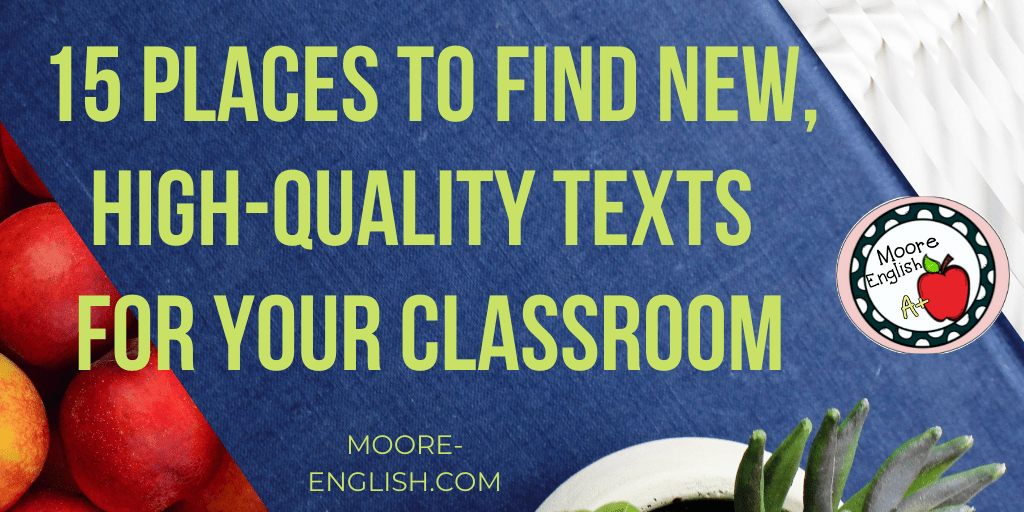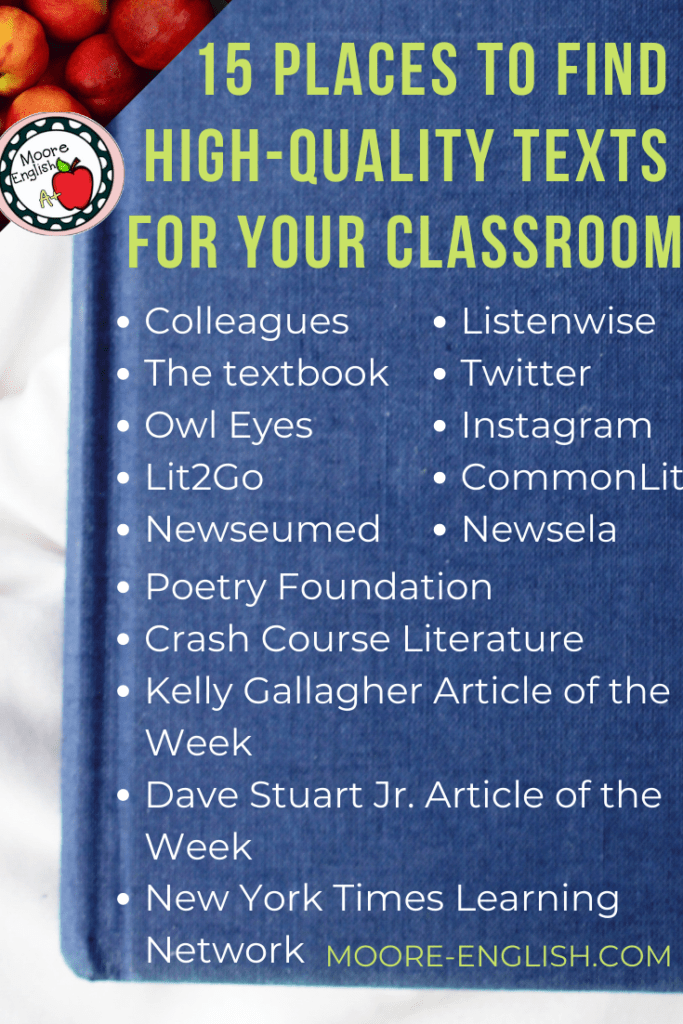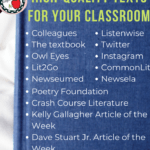How do you find a next text? This is a problem that probably plagues ELA teachers more than most. Last week I shared all the reasons I find myself sometimes looking for new texts. But recognizing that my students need a new text is easy. Finding the right text can be much more difficult, so this week I want to acknowledge all the challenges inherent in finding a new text. Then, I have some solutions to share.
What is it so hard to find a new text?
The Quest: First, my own boredom is never my reason for seeking a new text. Instead, I’m motivated by student needs, interests, and assessment data. So when I’m looking for a new text, I usually have a specific goal in mind. However, finding a text to match a specific skill, standard, or reading level can be difficult.
The Time: When I’m searching for a new text, my needs are specific. But I also need to match those needs against reading level, length, and content. Of course, this means that finding a single new text can take an obscene amount of time. And, sometimes, the quest is fruitless. You don’t find the one text you need!
Everything Else: Finding a new text is just the first part of the quest. Once you have the text, you still have to read it throughly yourself, decide how you will present the text to students, determine what students will do with the text, and determine how you will assess student understanding. In other words, there’s an incredible amount of work to do before presenting this text to students. In fact, there’s so much work that we’re going to talk all about it next week.

This post this post may contain affiliate links. Please read the Terms of Use.
What do you need to know to find a text?
Before you begin searching for a text, I encourage you to nail down a few details.
What kind of text do you want? A poem? An article? A picture? Because each of these texts has its own unique reading requirements: annotating a poem is different from annotating an article or picture.
What purpose will this text serve? Modeling? Assessment? Independent practice? Because each of these purposes requires a different reading level and text length: modeling should probably happen just below grade level, partner or group practice should happen just above grade level, and assessment should happen at grade level.
What is the thing you need this text to do? Help students practice making predictions? Provide students with an opportunity to synthesize theme? Help students infer? Determine main idea? Determine author’s purpose? Because each of these things requires something different: prediction and questioning the text can work with much shorter texts while synthesis may require something more substantive.
If you can answer these questions, you can make your search a lot more efficient.
Where do I look for new texts?
Don’t reinvent the wheel! As one of my co-workers often says, “work smarter, not harder.” So before you spend hours combing the Internet for a new text, I strongly encourage you to ask around. My co-workers are often the people that point me toward exactly the right tool. For example, when I was first looking for paired text for To Kill a Mockingbird, a co-worker suggested “We Wear the Mask.” Similarly, my school librarians have been very helpful in finding texts for my students.
Don’t reject the textbook! I know…I know…not everyone has a textbook. And not every textbook is good. For example, my Pre-AP textbook is from 1991. So I can appreciate the special kind of agony that can come from searching a textbook for something you’re just not going to find. However, in an effort to save yourself some time, I do suggest checking the textbook index. This will take you 5 minutes. And it could be just the thing you need. Last year, after years of using an unexceptional copy of “A White Heron,” I realized my 1991 textbook had had the text all along.
If you need a text to practice annotation, check out Owl Eyes, which allows students to collaborate on their annotations. The website has a variety of public domain literature and capitalizes on the conversational way readers can interact with a text.
If you need an audio option, consider Lit2Go, which is part of the Educational Technology Clearinghouse hosted by the University of South Florida. As often as I can, I post links to Lit2Go on my GoogleClassroom to provide students with the opportunity to listen to a text. Check out more listening tools here.
If you need current events, articles, or informational texts, I think a lot of people will point you to Newsela. But I have to admit that this is a resource I haven’t used much because features keep getting restricted to paid accounts. If you have suggestions for using Newela, put them in the comments! However, I think the better resources are Kelly Gallagher and Dave Stuart Jr.’s collections of articles of the week. Because these resources are curated by teachers who are working with students right now, they are so valuable. And they both have a knack for choosing articles that are relevant and engaging for students. Finally, the New York Times Learning Network also has an impressive and growing list of article suggestions.
If you need primary source documents, check out Newseumed. My juniors must use a primary source document in their argumentative writing, and this was a perfect tool for them. I first heard about this tool from Caitlin Tucker and Cult of Pedagogy.
If you need poetry, you can’t do better than PoetryFoundation. For me, for whatever reason, poetry is almost always the type of text I need. This year, I found new texts about the American Dream, the Great Depression, and female perspectives just by choosing the best search terms.
If you need a new novel, watch Crash Course Literature. Firstly, John Green takes viewers through a wide variety of texts, some of which I didn’t know prior to listening to his videos. Secondly, this collection will give you an idea of some new novels to try with students, or, at the very least, will give you an idea of where to begin. In an effort to help, I also have a complete set of listening guides here.
If you need something short and sweet, consider Listenwise. I first encountered Listenwise through a textbook pilot earlier this year. But the audio files are free and pretty short. Last year, my state added a listening section to our state assessment. So my students and I used this a lot as test prep. The audio files cover a range of subjects, so you can almost always find something that will connect to what you’re reading in class. The Daring English teacher has a set of suggestions for using Listenwise here.
If you need pictures, New York Times Learning Network has a huge collection of picture prompts and graphs. These make great resources for journaling, Quick Writes, and teaching text features.
If you have time, ask for text recommendations on social media. Usually, I get some great ideas from Twitter. Recently, I asked for recommendations on Instagram. Of course, if it’s midnight and you need a new text tomorrow, this may take more time than you have. But professional learning networks are a great source of inspiration.
If you need everything, try Commonlit. Of all the resources listed here, Commonlit is the most comprehensive. It will break down texts into thematic units, by grade level, by genre, or by skill. When I am looking for a speech, this is often where I look first. All the texts come with questions and have meaningful text features. Half the time when I’m looking for a text, what I really need is a student-friendly version of the text, and Commonlit can usually provide that.
Epilogue: What next?
Let me end with this: you don’t have to buy anything to teach a new text. While it takes plenty of time to find a new text, it shouldn’t take all your money. So please do not feel like you have to purchase anything in the pursuit of new texts. There are plenty of free resources listed above that will help you find exactly what your students need.
Once you find a new text, you also have to figure out how to roll that out to students. Next week, we will talk about everything involved in preparing to present a new text to students. What other suggestions do you have for finding new texts? Let us know in the comments!

Photo from Ivory Mix









